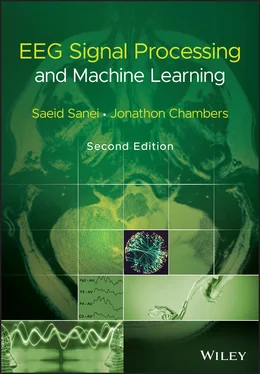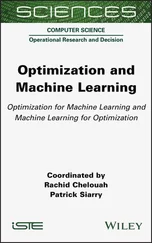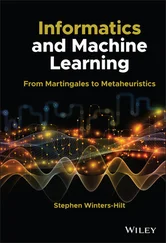Saeid Sanei - EEG Signal Processing and Machine Learning
Здесь есть возможность читать онлайн «Saeid Sanei - EEG Signal Processing and Machine Learning» — ознакомительный отрывок электронной книги совершенно бесплатно, а после прочтения отрывка купить полную версию. В некоторых случаях можно слушать аудио, скачать через торрент в формате fb2 и присутствует краткое содержание. Жанр: unrecognised, на английском языке. Описание произведения, (предисловие) а так же отзывы посетителей доступны на портале библиотеки ЛибКат.
- Название:EEG Signal Processing and Machine Learning
- Автор:
- Жанр:
- Год:неизвестен
- ISBN:нет данных
- Рейтинг книги:3 / 5. Голосов: 1
-
Избранное:Добавить в избранное
- Отзывы:
-
Ваша оценка:
- 60
- 1
- 2
- 3
- 4
- 5
EEG Signal Processing and Machine Learning: краткое содержание, описание и аннотация
Предлагаем к чтению аннотацию, описание, краткое содержание или предисловие (зависит от того, что написал сам автор книги «EEG Signal Processing and Machine Learning»). Если вы не нашли необходимую информацию о книге — напишите в комментариях, мы постараемся отыскать её.
EEG Signal Processing and Machine Learning — читать онлайн ознакомительный отрывок
Ниже представлен текст книги, разбитый по страницам. Система сохранения места последней прочитанной страницы, позволяет с удобством читать онлайн бесплатно книгу «EEG Signal Processing and Machine Learning», без необходимости каждый раз заново искать на чём Вы остановились. Поставьте закладку, и сможете в любой момент перейти на страницу, на которой закончили чтение.
Интервал:
Закладка:
The CNS stimulants increase the alpha and beta wave activities and reduce the amplitude and the amount of slow waves and background EEGs [69].
The effect of many other drugs especially antiepileptic drugs is investigated and new achievements are published frequently. One of the significant changes of the EEG of epileptic patients with valproic acid consists of reduction or even disappearance of generalized spikes along with seizure reduction. Lamotrigine is another antiepileptic agent that blocks voltage‐gated sodium channels thereby preventing excitatory transmitter glutamate release. With the intake of lamotrigine a widespread EEG attenuation occurs [69].
Penicillin if administered in high dosage may produce jerks, generalized seizures, or even status epilepticus [69].
2.10 Summary
In this chapter the formation of EEG signals have been briefly explained. The conventional measurement setups for EEG recording and the brain rhythms present in normal or abnormal EEGs have also been described. In addition, the effects of popular brain abnormalities such as mental diseases, ageing, and epileptic and nonepileptic attacks have been pointed out. Despite the known neurological, physiological, pathological, and mental abnormalities of the brain mentioned in this chapter, there are many other brain disorders and dysfunctions which may or may not manifest some kinds of abnormalities in the related EEG signals.
Sleep, fatigue, ageing, emotions and many other states of the human body can directly or indirectly manifest themselves in the EEG patterns. Neurodevelopmental disorders, particularly those with human behaviour have become attractive areas of research as they are associated with child personality development.
Degenerative disorders of the CNS [70, 71] such as a variety of lysosomal disorders, several peroxisomal disorders, a number of mitochondrial disorders, inborn disturbances of the urea cycle, many aminoacidurias, and other metabolic and degenerative diseases as well as chromosomal aberrations have to be evaluated and their symptoms correlated with the changes in the EEG patterns. The similarities and differences within the EEGs of these diseases have to be well understood. Conversely, the developed mathematical algorithms need to take the clinical observations and findings into account to further enhance the outcome of such processing. Although a number of technical methods have been well established for the processing of the EEGs with relation to the above abnormalities, there is still a long way to go and many questions to be answered.
The following chapters of this book introduce new digital signal processing and machine learning techniques employed mainly for analysis of EEG signals followed by a number of examples in the applications of such methods.
References
1 1 Walter, W.G. and Dovey, V.J. (1944). Electro‐encephalography in cases of sub‐cortical tumour. Journal of Neurology, Neurosurgery, and Psychiatry 7 (3–4): 57–65. https://doi.org/10.1136/jnnp.7.3‐4.57.
2 2 Ashwal, S. and Rust, R. (2003). Child neurology in the 20th century. Pediatric Research 53: 345–361.
3 3 Niedermeyer, E. (1999). The normal EEG of the waking adult, Chapter 10. In: Electroencephalography, Basic Principles, Clinical Applications, and Related Fields, 4e (eds. E. Niedermeyer and F.L. Da Silva), 174–188. Lippincott Williams & Wilkins.
4 4 Pfurtscheller, G., Flotzinger, D., and Neuper, C. (1994). Differentiation between finger, toe and tongue movement in man based on 40 Hz EEG. Electroencephalography and Clinical Neurophysiology 90: 456–460.
5 5 Adrian, E.D. and Mattews, B.H.C. (1934). The Berger rhythm, potential changes from the occipital lob in man. Brain 57: 345–359.
6 6 Trabka, J. (1963). High frequency components in brain waves. Electroencephalography and Clinical Neurophysiology 14: 453–464.
7 7 Cobb, W.A., Guiloff, R.J., and Cast, J. (1979). Breach rhythm: the EEG related to skull defects. Electroencephalography and Clinical Neurophysiology 47: 251–271.
8 8 Roldan, E., Lepicovska, V., Dostalek, C., and Hrudova, L. (1981). Mu‐like EEG rhythm generation in the course of hatha‐yogi exercises. Electroencephalography and Clinical Neurophysiology 52: 13.
9 9 IFSECN (1974). A glossary of terms commonly used by clinical electroencephalographers. Electroencephalography and Clinical Neurophysiology 37: 538–548.
10 10 Jansen, B.H. and Rit, V.G. (1995). Electroencephalogram and visual evoked potential generation in a mathematical model of coupled cortical columns. Biological Cybernetics 73: 357–366.
11 11 David, O. and Friston, K.J. (2003). A neural mass model for MEG/EEG coupling and neuronal dynamics. NeuroImage 20: 1743–1755.
12 12 Marey, E.J. and Lippmann, G. (1876). Des variations electriques des muscles du coeur en particulier etudiees au moyen de l’electrometre di. M. Lippmann. Comptes Rendus 82: 975–977.
13 13 Gotman, J., Ives, J.R., and Gloor, R. (1979). Automatic recognition of interictal epileptic activity in prolonged EEG recordings. Electroencephalography and Clinical Neurophysiology 46: 510–520.
14 14 Jasper, H. (1958). Report of committee on methods of clinical exam in EEG. Electroencephalography and Clinical Neurophysiology 10: 370–375.
15 15 Bickford, R.D. (1987). Electroencephalography. In: Encyclopedia of Neuroscience (ed. G. Adelman), 371–373. Cambridge (USA): Birkhauser.
16 16 Montoya‐Martínez, J., Vanthornhout, J., Bertrand, A., and Francart, T. (2021). Effect of number and placement of EEG electrodes on measurement of neural tracking of speech. PLoS ONE 16 (2): e0246769.
17 17 Collura, T. (1998). A guide to electrode selection, location, and application for EEG Biofeedback, Ohio. Proceedings of the 6th Annual Conference on Brain Function/EEG, Modification and Training, Palm Springs, CA (21–25 February).
18 18 Nayak, D., Valentin, A., Alarcon, G. et al. (2004). Characteristics of scalp electrical fields associated with deep medial temporal epileptiform discharges. Clinical Neurophysiology 115: 1423–1435.
19 19 Barrett, G., Blumhardt, L., Halliday, L. et al. (1976). A paradox in the lateralization of the visual evoked responses. Nature 261: 253–255.
20 20 Halliday, A.M. (1978). Commentary: Evoked Potentials in Neurological Disorders, Chapter: Event‐Related Brain Potentials in Man (eds. E. Calloway, P. Tueting and S.H. Coslow), 197–210. Academic Press.
21 21 Jarchi, D. and Sanei, S. (2010). Mental fatigue analysis by measuring synchronization of brain rhythms incorporating enhanced empirical mode decomposition. Proceedings of the 2nd International Workshop on Cognitive Information Processing (CIP). Elba, Italy.
22 22 Jarchi, D. and Sanei, S. (2010). A novel method for analysis of mental fatigue from normal brain rhythms. Proceedings of the 17th European Signal Processing Conference, EUSIPCO. Denmark.
23 23 Jarchi, D., Sanei, S., and Lorist, M.M. (2011). Coupled particle filtering: a new approach for P300‐based analysis of mental fatigue. Journal of Biomedical Signal Processing and Control 6 (2): 175–185.
24 24 Jarchi, D., Makkiabadi, B., and Sanei, S. (2009). Estimation of trial to trial variability of P300 subcomponents by coupled Rao‐Blackwellised particle filtering. Proceedings of the IEEE Workshop on Statistical Signal Processing, SSP2009. Cardiff, UK.
25 25 Jarchi, D., Makkiabadi, B., and Sanei, S. (2009). Separating and tracking ERP subcomponents using constrained particle filter. Proceedings of the 16th International Conference on Digital Signal Processing, DSP2009, Greece.
26 26 Davidson, R.J. and Henriques, J.B. (2000). Regional brain function in sadness and depression. In: The Neuropsychology of Emotion (ed. J.C. Borod), 269–297. New York: Oxford Press.
Читать дальшеИнтервал:
Закладка:
Похожие книги на «EEG Signal Processing and Machine Learning»
Представляем Вашему вниманию похожие книги на «EEG Signal Processing and Machine Learning» списком для выбора. Мы отобрали схожую по названию и смыслу литературу в надежде предоставить читателям больше вариантов отыскать новые, интересные, ещё непрочитанные произведения.
Обсуждение, отзывы о книге «EEG Signal Processing and Machine Learning» и просто собственные мнения читателей. Оставьте ваши комментарии, напишите, что Вы думаете о произведении, его смысле или главных героях. Укажите что конкретно понравилось, а что нет, и почему Вы так считаете.












